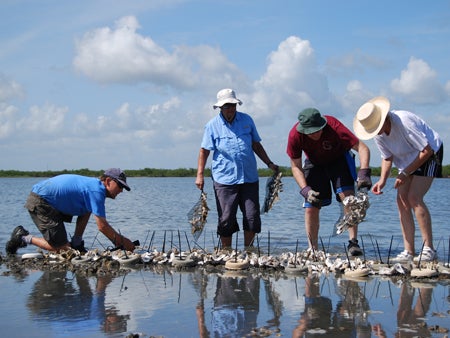Five years of restoring oyster reefs off Canaveral National Seashore could help revive the Gulf of Mexico’s decimated oyster populations.
UCF on YouTube: Learn more about UCF’s work with oysters and what could happen to these special shellfish affected by the BP oil spill here.
Data collected by researchers from the University of Central Florida and The Nature Conservancy also could help save fragile ecosystems along Florida’s East Coast should the oil threaten them.
Already in global decline, oyster reefs are one of the most critical marine habitats because they filter water, provide food and shelter for other creatures and help stabilize shorelines. Initial estimates from the oil spill put oysters’ fate in even more jeopardy, and halting the Gulf’s multi-million-dollar harvesting industry has hurt fishermen and restaurant owners.
Linda Walters, a UCF biology professor, has led restoration efforts in Brevard County’s Mosquito Lagoon since 2005. Working in partnership with
The Nature Conservancy, she has restored 41 oyster reefs – or about 10 acres of shellfish – with the help of more than 16,000 volunteers.
“People in Central Florida realize the importance of their coastal waters, and once they learn how significant oysters are for purifying the water and supporting other species, they’re excited to help,” Walters said.
Using mesh mats, empty oyster shells, zip ties and concrete donut weights, volunteers place the homemade contraptions in the shallow waters of Mosquito Lagoon, one of the nation’s most biologically diverse estuaries. The mats give oyster larvae a stable place to live, saving them from being kicked up by boat wakes or washed ashore to die.
Since the oil spill, Walters has been working with state biologists, as well as the U.S. National Park Service, to offer her findings to restoration efforts and marine ecosystem research off Florida’s coasts and in the Gulf of Mexico. She is a part of a statewide university task force dedicated to responding to the disaster.
She also is collaborating with oyster researchers in Apalachicola Bay, where booms are already in place in response to the oil spill and 90 percent of Florida’s oysters are harvested.
Combining scientists’ brainpower and research into one central clearing hub is probably the best outcome of this tragedy, she says, and that could help with the eventual environmental restoration efforts tied to the cleanup.
In Mosquito Lagoon, keeping the reefs alive and healthy means maintaining more than 140 other species. “If we didn’t have the oyster reefs, the fish numbers would go way down, and we would lose all the blue crabs and the shrimp,” Walters said. “Without the oysters, this lagoon would just be a sandy bottom with a few worms.”
Walters said she’s already received hundreds of phone calls from people eager to get involved with marine restoration. Children, scout troops, visitors at the Brevard Zoo’s oyster reef exhibit, women’s clubs and corporate groups have helped to either make the mats or deploy them in the lagoon.
The project also recently received a huge boost thanks to an international online voting contest through Disney’s Friends for Change: Project Green. The $100,000 grant awarded to The Nature Conservancy will help ensure the continuation of this important restoration and research project.
“It has been a wonderful partnership with UCF and the community,” said Anne Birch, The Nature Conservancy’s Florida director of coastal restoration. “It offers so many people a hands-on, tangible way to help conserve our marine waters and the species that live there.”
To learn how you can get involved with the Mosquito Lagoon Oyster Reef Restoration project, visit nature.org/en-us/about-us/where-we-work/united-states/florida/stories-in-florida/bringing-back-oysters-to-charlotte-harbor.
